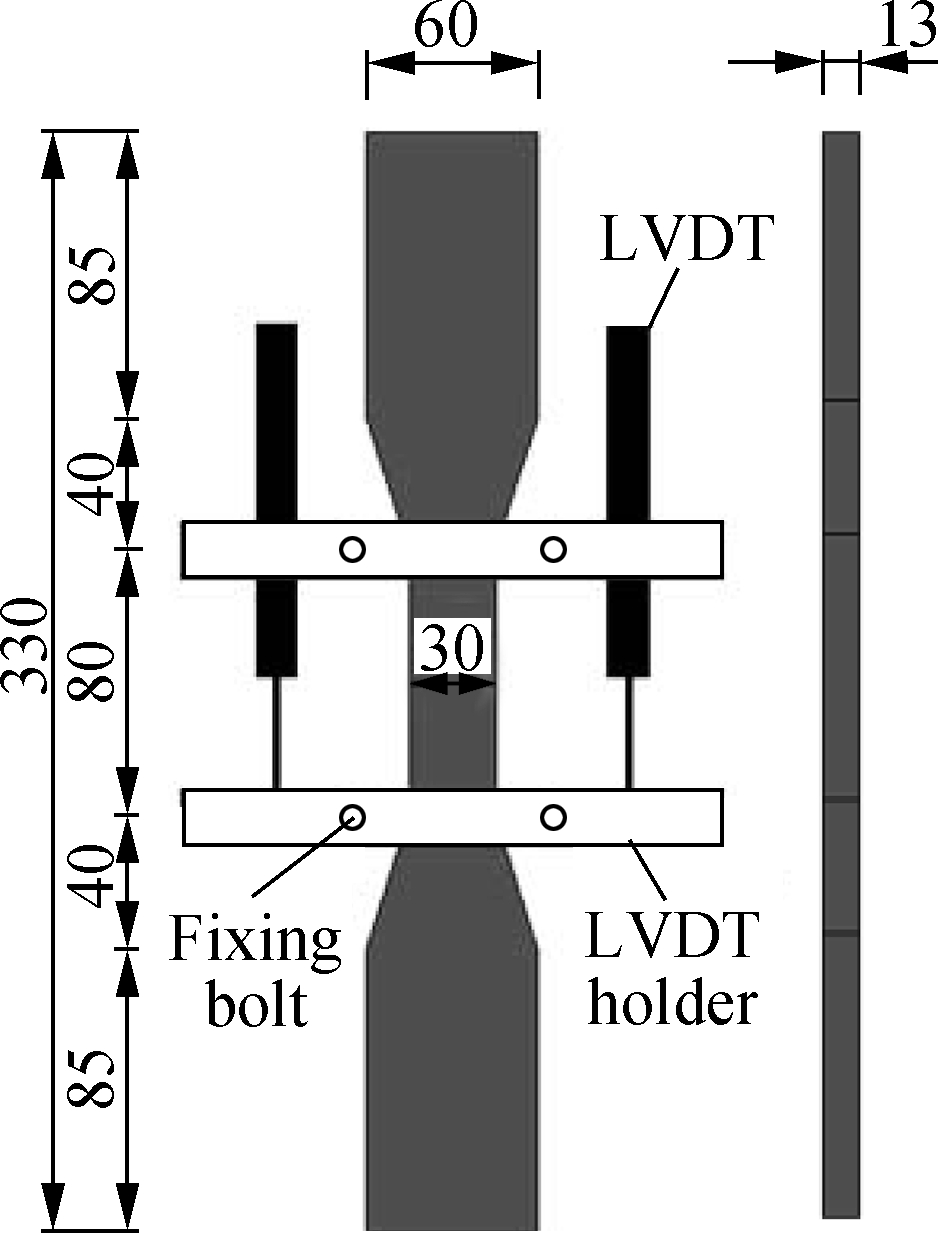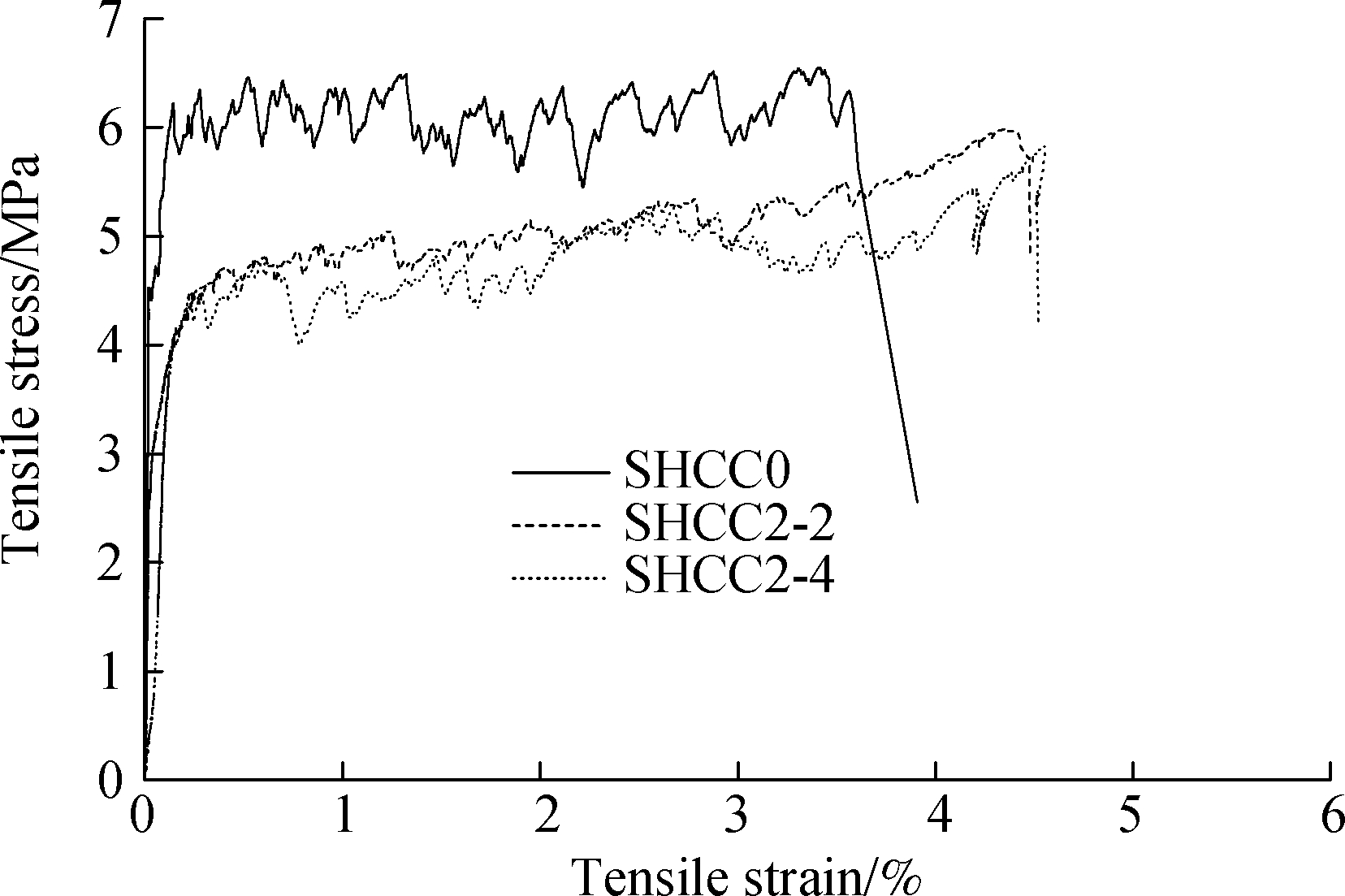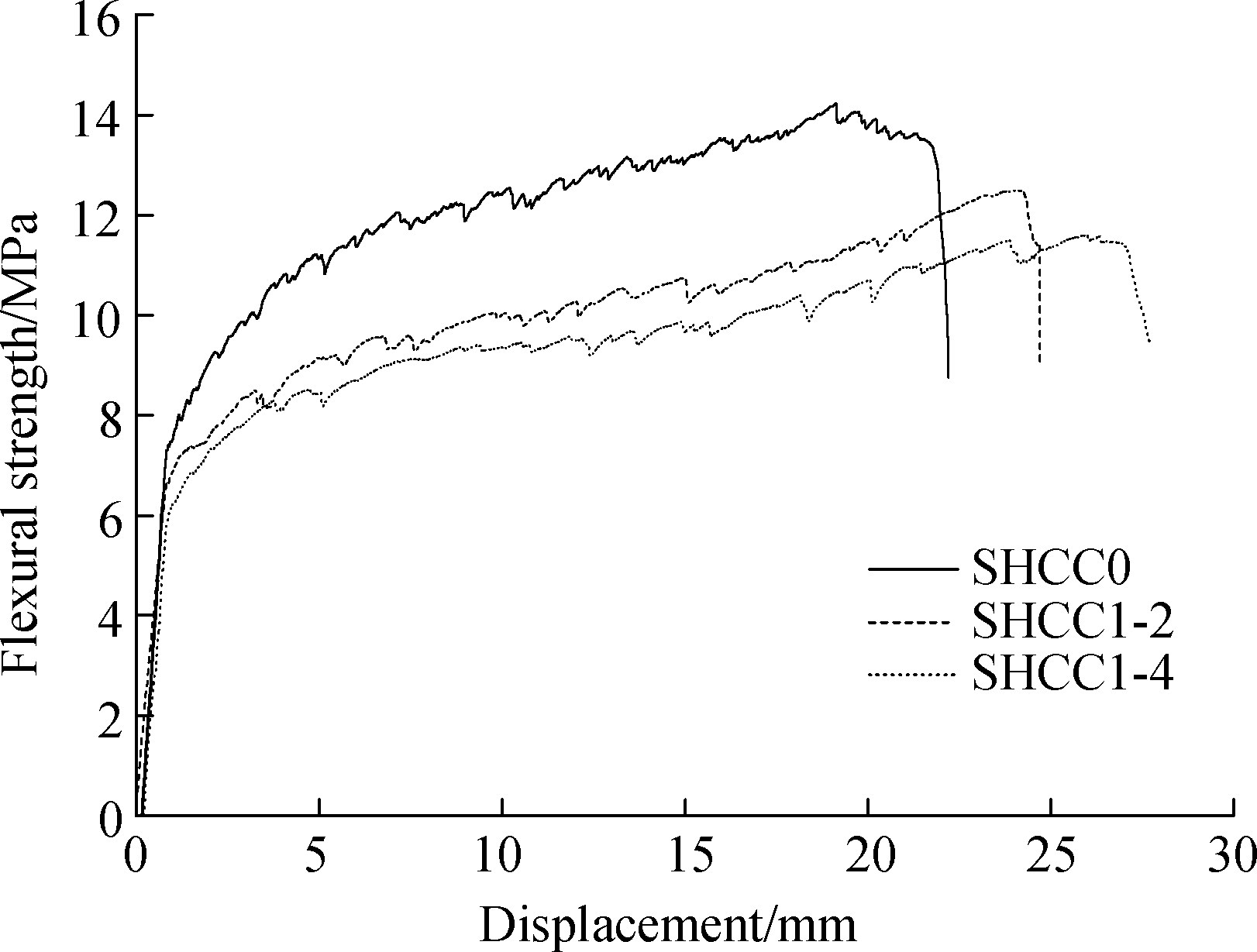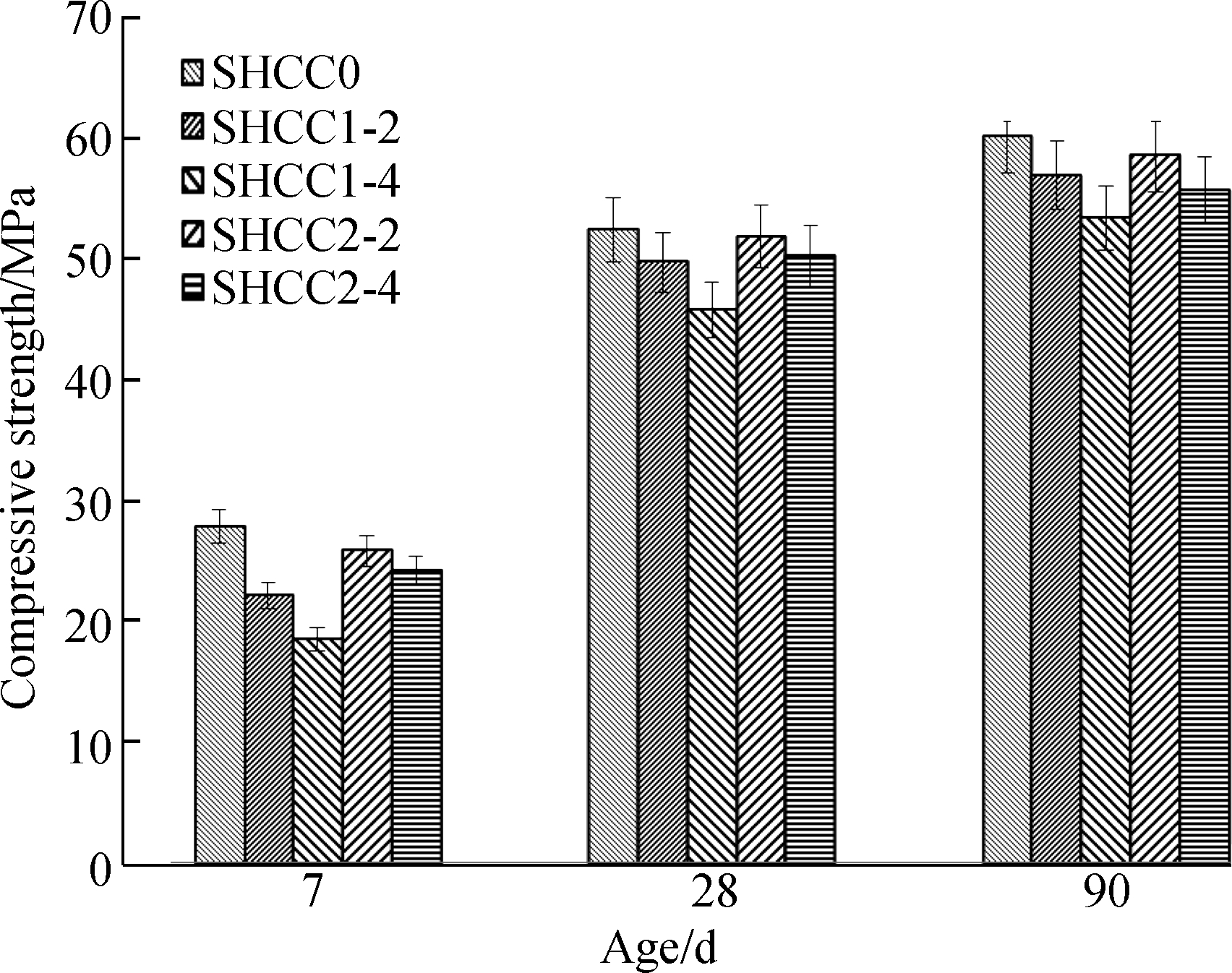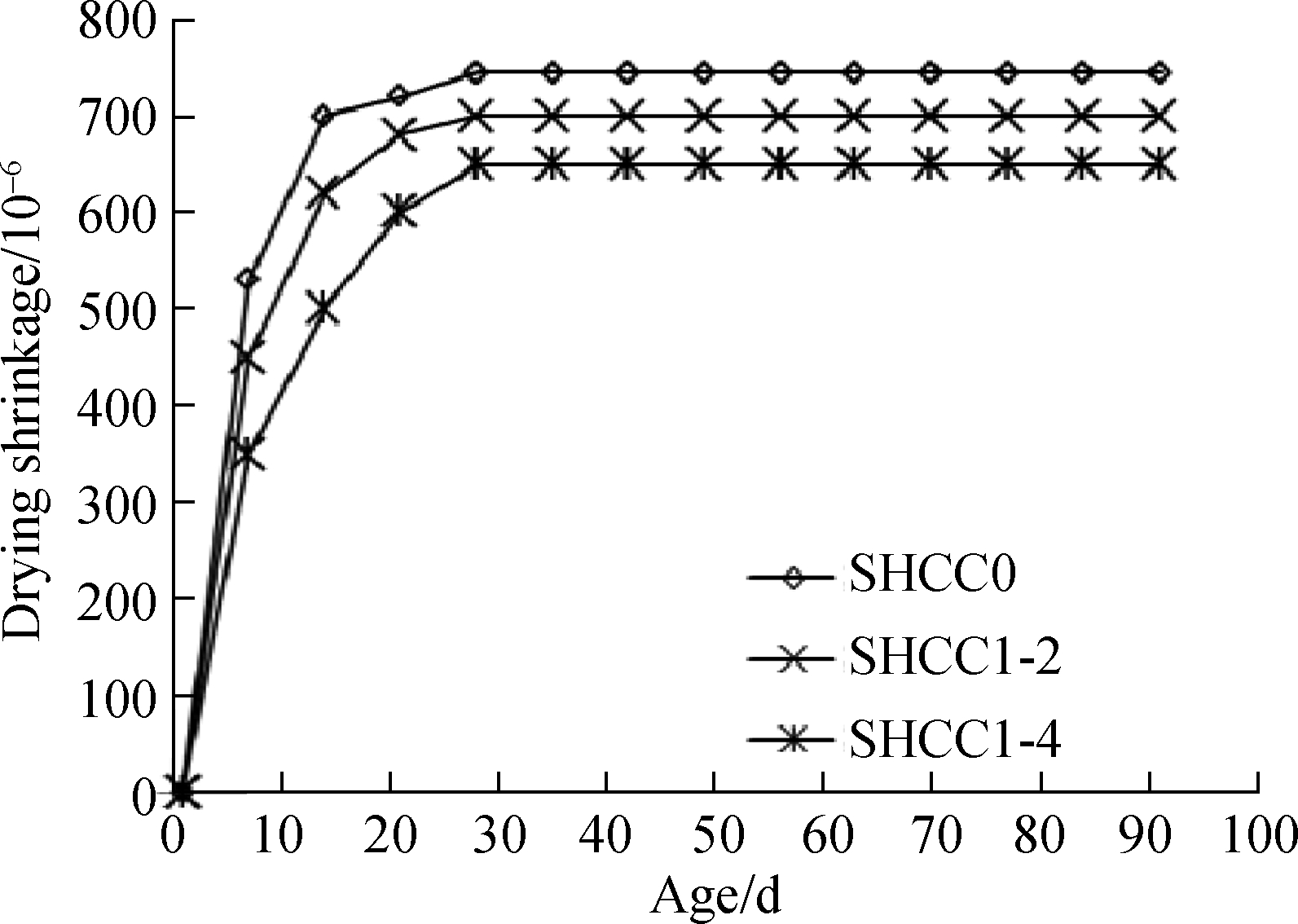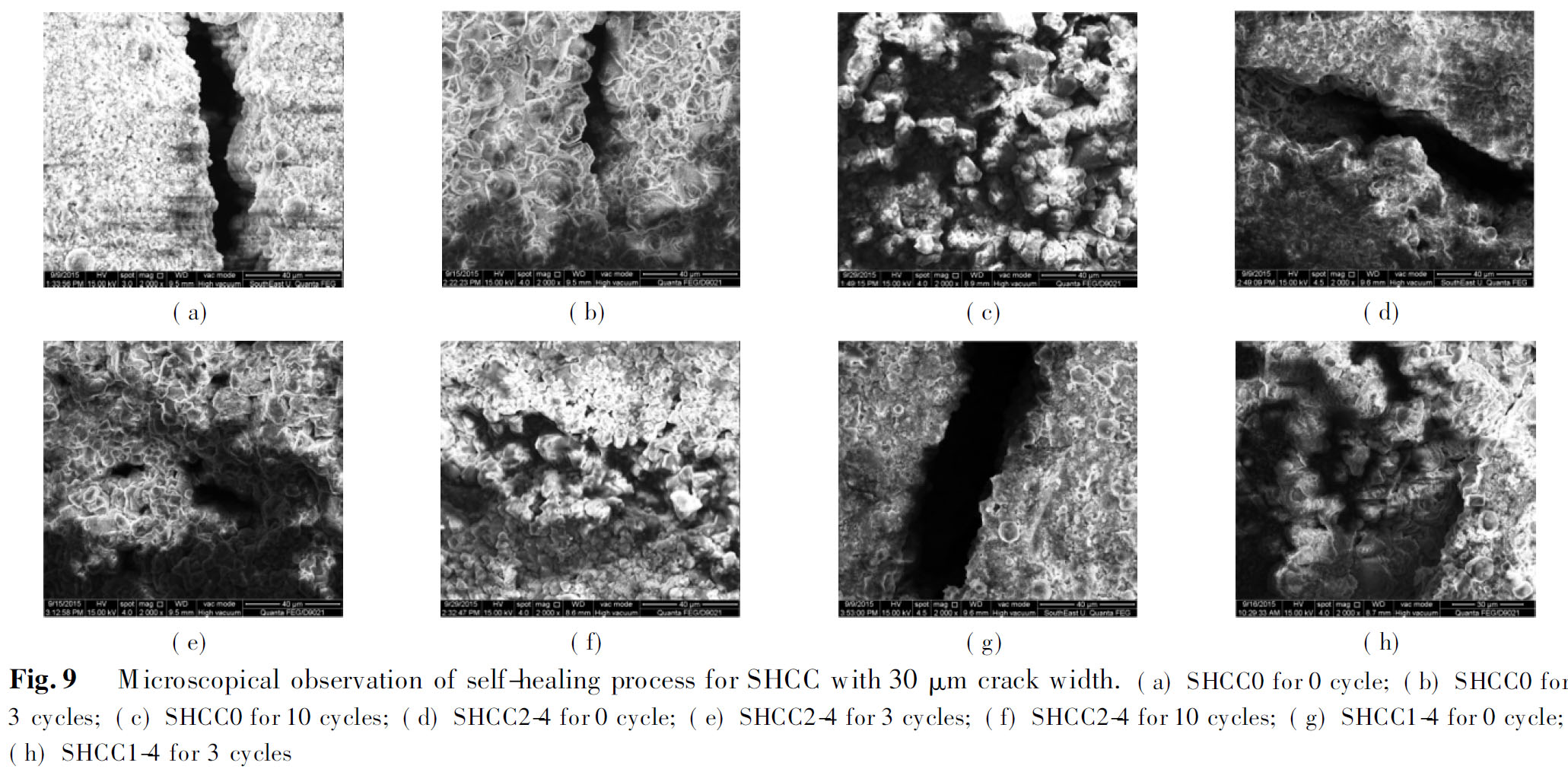Mechanical property of strain-hardening cementitious composites modified with superabsorbent polymers
Deng Hanwen
(School of Transportation, Southeast University, Nanjing 210096, China)
Abstract:In order to improve the tensile property, flexural property and drying shrinkage of strain-hardening cementitious composites (SHCC), mixtures quantitatively modified with superabsorbent polymer (SAP) were investigated. The uniaxial tensile test, the four-point bending test, the compressive test, the drying shrinkage test and the environmental scanning electron microscope (ESEM) were employed to investigate the tensile strain capacity, flexural deformation capacity, compressive strength, drying shrinkage, crack width and self-healing of SHCC. The experimental results show that SHCC modified with SAP particles exhibits excellent ductility and deformability, and the tensile strain is up to about 4.5% and the average crack width is controlled around 40 μm. Meanwhile, the drying shrinkage of SHCC modified with SAP particles can reduce by about 60%. Furthermore, the self-healing behavior is observed in the cracks of specimen after three cycles of high-low relative humidity curing, and the self-healing products can completely fill the cracks of SHCC specimens modified with SAP particles. It is, therefore, feasible to produce SHCC material modified with SAP particles, while simultaneously retaining higher material ductility.
Keywords:strain-hardening cementitious composites (SHCC); superabsorbent polymer (SAP);mechanical property; self-healing
Biography:Deng Hanwen (1986—), male, graduate.
Strain-hardening cementitious composites (SHCCs, also called engineered cementitious composites, ECCs), are a new kind of high performance fiber-reinforced cementitious composites (HPFRCCs) and have been developed widely since they were researched by Li and coworkers in the 1990s[1]. According to micromechanics and the fracture mechanics theory, SHCC is modified by fiber geometry, matrix toughness, and interface properties[2-3]. SHCC exhibits multiple-cracking and strain-hardening behavior under uniaxial tension[4-6].Wang et al.[7]demonstrated that controlling matrix toughness in SHCC mix design to achieve strain-hardening is feasible, in which low matrix toughness leads to high strain capacity for given fiber geometry and interface properties.
In the past years, better tensile ductility and saturated multiple cracking of SHCC have been achieved by a number of researchers.Zhang et al.[8]founded that increasing fly ash content can improve the deformability of SHCC. Yang et al.[9]used high volumes of fly ash (FA) in SHCC to obtain a higher tensile ductility of about 3%and achieve more saturated cracking behavior. Ma et al.[10]found that the tensile strain capacity of SHCC increases significantly with the fly ash content from 1.5% at FA/C=1.2 to 4.5% at FA/C=4.0.SHCC with ground granulated blast furnace slag (GGBS) also shows high ductility and enhanced workability due to the oxidized grain surface of GGBS[11].On the other hand, adding artificial flaws can also improve SHCC’s ductility and toughness by adjusting its matrix properties. Li et al.[12]investigated the effect of matrix flaw size distribution on the strength and cracking space of SHCC by a Monte Carlo process and assumed that flaw size distribution follows a Weibull distribution. Also, a good agreement between the simulation results and experimental data is found in polyethylene fiber reinforced cement-based-composites. Wang et al.[7]analyzed the feasibility of using polyethylene (PP) beads as an artificial flaw to decrease the matrix toughness and achieve saturated multiple cracking.However, the replacement of silica sand with saturated lightweight fine aggregates (LWA) is not conducive to the ductility and strength of SHCC. The above investigations show that it is difficult to effectively control the size distributions of PP and LWA in mixtures.
Use of superabsorbent polymers(SAPs) has been paid more attention to in recent years[13-19].SAPs are a class of hydrogels that can absorb a significant amount of liquid from the surrounding environment up to 1 500 times their dry mass[15]. Their capacity and kinetics can be effectively applied in concrete by altering their chemical and physical characteristics during the synthesis of these hydrogels. The ability to change the size distribution and absorption behavior of SAPs provides a significant advantage over LWA. SAPs can not only maintain a high relative humidity but also prevent autogenous shrinkage in the cementitious materials in the early age. Moreover, water released from SAPs can contribute to further hydration of unhydrated cementitious particles, thus improving the microstructure and durability of the concrete[17,20].
In order to improve the matrix toughness to obtain good ductility and strain-hardening behavior, this paper focuses on developing SHCC with two types of superabsorbent polymer (SAP) particles. The effect of SAP in SHCC matrix was experimentally investigated and the effectiveness of modified matrix was also discussed by tailoring the size distribution of SAP. The experimental program includes two variables—SAP addition of 2% and 4% by weight of cement and two different sizes of SAP particles. Additionally, the results of the four-point bending test, uniaxial tensile test, compressive strength test, drying shrinkage test and environment scanning electron microscope (ESEM) observation are analyzed to demonstrate the feasibility of SHCC modified with SAPs.
1 Experimental Program
1.1 Materials
As shown in Tab.1, the SHCC mixture includes Portland cement, fly ash, silica sand, SAP particles and PVA fibers. In total, there are two types of SAP particles produced in Hebei province. SAP1 and SAP2 are a copolymer of polyacrylate particles with a mean size of 550 and 75 μm, respectively. A high-range water-reducing admixture (HRWRA) volume of 3% is adopted due to the difficulty of mixing with 4% SAP1 particles, which have greater diameters and tend to conglomerate during mixing (see Fig.1).
Tab.1 Mix proportion of SHCC mixtures kg/m3

MixtureIDCementFASandWaterSAP1SAP2HRWRAFiberW/BSHCC05097634623110010260.25SHCC1⁃250976346231110.2010260.25SHCC1⁃450976346231120.4015260.25SHCC2⁃2509763462311010.210260.25SHCC2⁃4509763462311020.410260.25
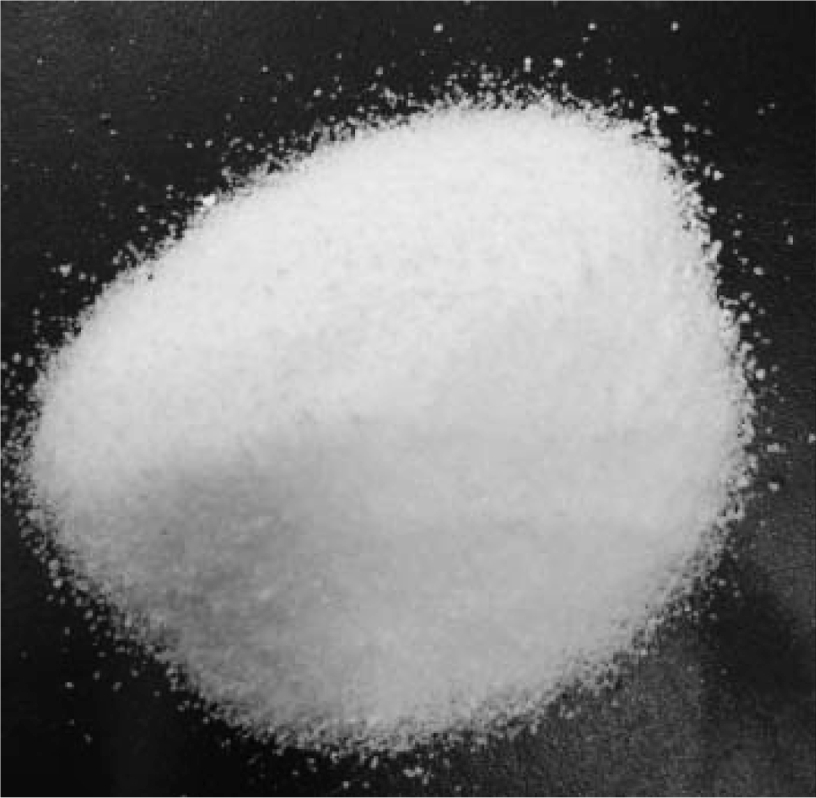
(a)
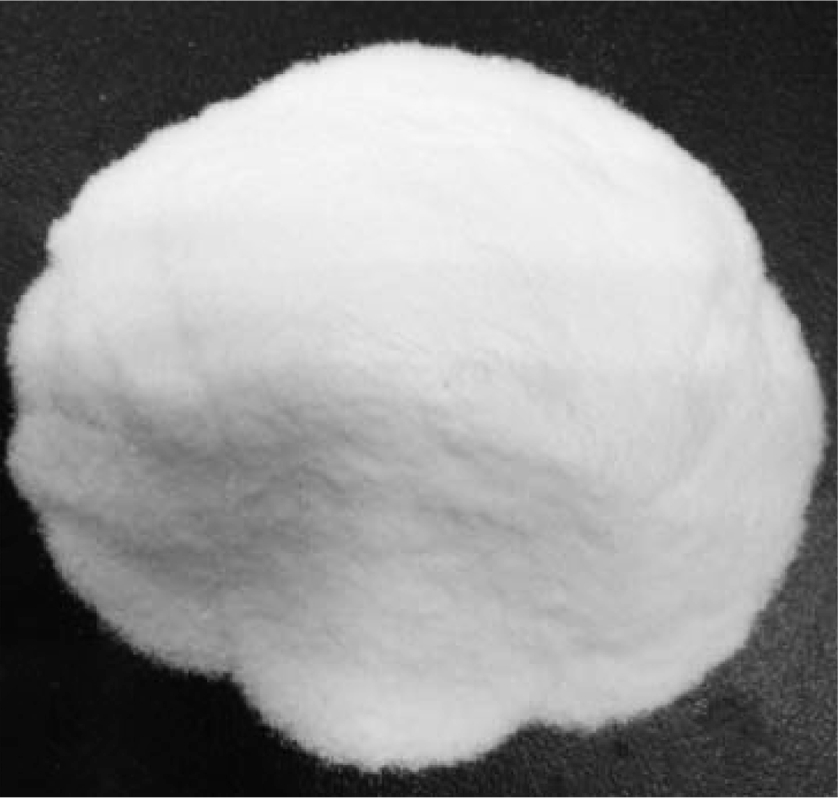
(b)
Fig.1 Images of different SAP particles.(a) SAP1; (b) SAP2
1.2 Mixing and testing
The raw materials are first mixed in a planetary mixer with 10 L capacity for 2 min at a low speed, followed by the addition of water and high-range water-reducing admixture. Mixing continues at a low speed for 4 min and then at high speed for 2 min. The PVA fibers are slowly added into the fresh mortar, and the mixture is mixed at high speed for another 5 min.Therefore, the fibers are dispersed well in mixtures.The fresh SHCC is then cast into steel mold and demold after 1 d. After demolding, all specimens are cured for 28 d in a standard curing room until testing where the temperature and relative humidity are (20±2)℃ and (90±5)%, respectively.
For each mixture, four SHCC specimens are prepared for the direct tensile test, the specimen geometry is shown in Fig.2. Nine 75 mm×75 mm×75 mm prism specimens are prepared for the compressive strength test. Four 400 mm×100 mm×160 mm coupon specimens are prepared for the four-point bending test. The full span of the four-point bending test is 300 mm. The test is performed under displacement control at a loading rate of 1.0 mm/min.
2 Results and Discussion
2.1 Tensile property of SHCC
Typical tensile stress-strain curves of newly developed SHCC mixtures modified with SAP particles at 28 d are presented in Figs.3(a) and (b). Tab.2 displays the results of direct tensile test in terms of tensile stress, tensile strain capacity at the peak stress and the average residual crack width of SHCC specimens. As shown in Tab.2, the ultimate tensile strain of SHCC ranging from 3.29% to 4.64% is much better than that of other HPFRCCs.
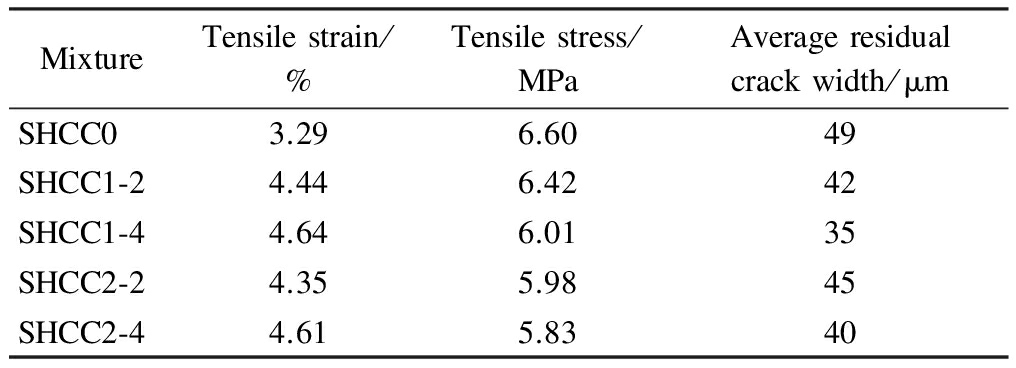
MixtureTensilestrain/%Tensilestress/MPaAverageresidualcrackwidth/μmSHCC03.296.6049SHCC1⁃24.446.4242SHCC1⁃44.646.0135SHCC2⁃24.355.9845SHCC2⁃44.615.8340
As displayed in Fig.3, incorporating SAP particles into matrix can apparently improve the strain capacity of SHCC. For example, the tensile strain capacity of SHCC specimens with SAP1 is 3.29%, 4.44% and 4.64% when the SAP1 content is 0, 2% and 4%, respectively. Compared with SHCC0, the tensile capacity of SHCC1-2 and SHCC1-4 is increased by 35% and 41%, respectively. For SHCC specimens with SAP2, compared to SHCC0, the tensile capacity of SHCC2-2 and SHCC2-4 is increased by 30% and 39%, respectively. When the SAP content is constant, SAP particles have a greater influence on SHCC specimens with a greater diameter. However, incorporating SAP particles into matrix can decrease the first cracking strength and tensile stress of SHCC, which is in agreement with Ref.[13]. These will be further proved by the following part on compressive strength in this research. Meanwhile, increasing SAP content can apparently decrease the first cracking strength and tensile stress of SHCC specimens. For example, compared to SHCC0, the first cracking strength of SHCC1-2 and SHCC1-4 is reduced by 11% and 16%, respectively. According to the micromechanics theory, lower strength due to SHCC matrix modified with SAP particles is expected to contribute to improving the tensile strain capacity[3].
As listed in Tab.2, it is easily found that average residual crack width decreases with the increase of SAP content. Meanwhile, the effect of SAP particles with greater size on the residual crack width of SHCC specimens is more apparent than that of SAP2. According to Refs.[8,21-22], smaller crack width in SHCC specimens can effectively promote self-healing behavior and improve the durability of the concrete structure.
2.2 Flexural property of SHCC
The typical flexural strength-displacement curves of all SHCC specimens are shown in Figs.4(a) and (b). In these curves, the maximum flexural stress is defined as the ultimate flexural strength, and the corresponding displacement is defined as the flexural deformation capacity. The flexural stiffness is defined as the slope of the flexural strength-displacement curve.
As seen from Tab.3, the average flexural strength of all SHCC specimens changes from 11.4 to 14.4 MPa. SAP particles can lower flexural strength. Meanwhile, flexural strength decreases as SAP content increases from 2% to 4%. For example, compared with SHCC0, the flexural strength of SHCC1-2 and SHCC1-4 is decreased by 13% and 20%,respectively. As displayed in Fig.4 and Tab.3, the flexural deformation of SHCC specimens increases with the increase of SAP content, which can reflect material ductility and toughness to some extent.For all SHCC mixtures with the same SAP content, the highest mid-span deformation is observed for the SHCC specimen modified with 4% of SAP1. Compared with SHCC0, the flexural deformation of SHCC1-2 and SHCC1-4 is increased by 11% and 21%.However, the flexural deformation of SHCC2-2 and SHCC2-4 is only increased by 3% and 6%,respectively. Moreover, it can be easily noted from Figs.4(a) and (b) that the slope slightly decreases with SAP content, thereby implying a reduction in the flexural stiffness of SHCC specimens. The above results indicate that SHCC modified with larger SAP has a significant improvement in flexural mechanical properties.
Tab.3 Flexural properties of SHCC specimens at 28 d
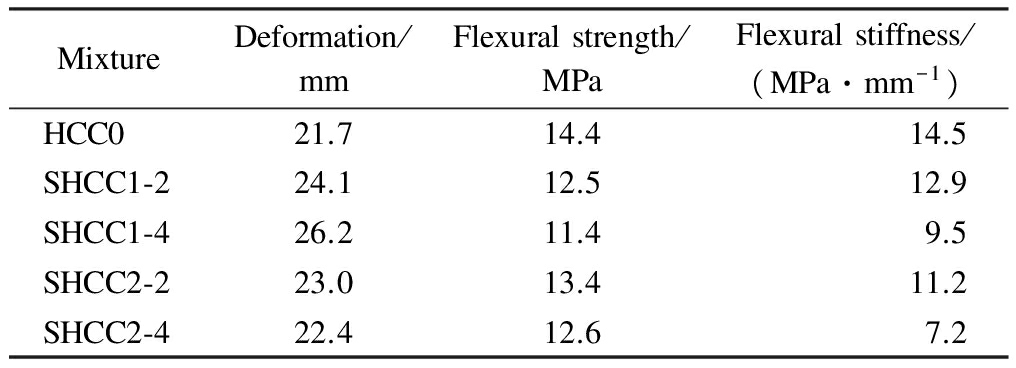
MixtureDeformation/mmFlexuralstrength/MPaFlexuralstiffness/(MPa·mm-1) HCC021.714.414.5 SHCC1⁃224.112.512.9 SHCC1⁃426.211.49.5 SHCC2⁃223.013.411.2 SHCC2⁃422.412.67.2
It can be concluded that the deformation of SHCC modified with SAP particles at peak load is 1.2 times that of control ones, which is exciting and was expected for the authors in this paper. The SHCC specimen also shows typical flexural and multiple cracking behavior, as shown in Fig.5. A possible mechanism to explain the increase of flexural deformation in SHCC is that SAP particles act as artificial flaws to trigger initial cracking and easily develop in the SHCC matrix, which can help SHCC specimens to exhibit multiple-cracking and strain-hardening behavior[12].
2.3 Compressive strength
Fig.6 displays the compressive strength of SHCC specimens with different SAP contents at 7, 28 and 90 d, respectively. As shown in Fig.6, as expected, the compressive strength of SHCC specimens incorporating SAP particles is lower than that of control SHCC specimens (SHCC0). Meanwhile, increasing SAP content can further reduce the compressive strength of SHCC mixtures. For example, compared with SHCC0 at 28 d, the compressive strength of SHCC1-2 and SHCC1-4 at 28 d is reduced by 5% and 13%, and the compressive strength of SHCC2-2 and SHCC2-4 at 28 d is reduced by 1% and 3%, respectively. However, the compressive strength of SHCC1-4 specimens with 4% SAP1 at 28 d is still more than 40 MPa, meeting the requirements of many concrete structure applications. For SHCC mixtures with SAP particles, an overall decrease in matrix strength has been noted mainly due to the formation of macro voids produced by SAP particles in cementitious materials[13,19]. The compressive strength of SHCC strengthens as curing age prolongs. Moreover, the more the SAP content, the higher the strength increasing ratio of matrix at later ages, due to water-entrained SAP particles.
2.4 Drying shrinkage
Drying shrinkage in all SHCC mixtures up to 90 d is shown in Figs.7(a) and (b). A minimum of three specimens is used to obtain the average results. Drying shrinkage of SHCC is much higher than that of normal concrete, due to the absence of coarse aggregate in the SHCC matrix. For all SHCC specimens, drying shrinkage increases as the age prolongs, initially at a rapid rate before first 14 d, but gradually stabilizes after 20 d. The drying shrinkage of all specimens ranges from 3.05×10-4to 7.44×10-4at 90 d. Meanwhile, SHCC specimens without SAP particles (SHCC0) show the highest drying shrinkage at all test ages. Adding SAP particles into SHCC mixtures can apparently decrease drying shrinkage. Moreover, increasing SAP content can further reduce the drying shrinkage of SHCC specimens. For example, compared with SHCC0, the drying shrinkage of SHCC1-2 and SHCC1-4 is decreased by 6% and 13%, the drying shrinkage of SHCC2-2 and SHCC2-4 is decreased by 57% and 61%, respectively.The higher reduction observed with SAP-2 may be due to the larger number of fine particles which can be available in the entire SHCC matrix. The above results show that SAP particles have an obvious effect on reducing the drying shrinkage of SHCC.
A possible mechanism which can explain the reduction of drying shrinkage in SHCC with SAP is that SAP particles in SHCC matrix lead to the formation of a swollen water-filled micropore polymer, which prevents moisture evaporation and provides water for curing SHCC specimens exposed to air conditions, promotes further hydration of unhydrated cement and reduces the drying shrinkage of SHCC specimens[14].
2.5 Self-healing behavior
In previous investigations[8,21-22], tight crack width has been found to promote self-healing behavior in SHCCs. There are many factors affecting the self-healing behavior; calcium carbonate deposition and continuous hydration of cement[22]are considered to be the two most important ones.
From Fig.8, it can be clearly seen that a large amount of white residue displays along crack lines after 10 cycles under high-low RH curing.To study the change of microstructure of crack in the self-healing process of SHCC, specimens were measured by the environmental scanning electron microscope (ESEM). Since all specimens do not have a conductive material surface on them, the ESEM was allowed continuous imaging during the self-healing process. After pre-loading at 7 d, bending specimens which contain cracks with a width of 30 μm were cut into 5 mm×5 mm×5 mm cubic samples. After starting imaging, the cubic samples were continued curing under high-low relative humidity cycles (95%/60% RH cycles) until testing time. The development of self-healing process on crack was followed by imaging and analyzing through ESEM after 3 and 10 cycles, respectively.
The self-healing phenomena under 0, 3 and 10 high-low relative humidity cycles (95%/60% RH cycles) are observed for a single crack of 30 μm width in SHCC specimens.As seen in Figs.9(a), (d) and (g), before self-healing, the cracks were clear to the naked eye, but after 3 cycles, an abundance of stone like healed products was filled in all the cracks of SHCC0 and SHCC2-4 (see Figs.9(b) and (e)). Particularly in SHCC1-4, more self-healing products were precipitated in the cracks, and the cracks were almost healed completely (see Fig.9(h)). However, this complete healing phenomenon occured in SHCC0, and SHCC2-4 needs 10 curing cycles(see Figs. 9(c) and (f)). The microscopical observations indicate that the self-healing of SHCC mainly occurred in the first three high-low RH cycles, during which the cracks could be healed up to about 80%, even 100%. All indications show that SAP particles can be helpful to the self-healing of ECC materials.These findings suggest that the larger particles of SAP1 can significantly contribute to the self-healing behavior.
3 Conclusions
1) Incorporating SAP particles can improve the tensile strain capacity and flexural deformation of SHCC specimens. For all SHCC specimens, the tensile strain capacity of SHCC mixtures modified with SAP particles can be increased by about 40%.
2) SAP particles can reduce the crack width of SHCC specimens, which can improve the durability of SHCC, conversely affecting the strength properties of the SHCC mixture, such as tensile stress, flexural strength and compressive strength. Compared with control specimens, the compressive strength of SHCC at 28 d is decreased by 5%to 13%. Moreover, SAP particles can be used as a water-entraining admixture in the SHCC matrix to reduce drying shrinkage.
3) Incorporating SAP particles can promote the self-healing behavior of SHCC specimens. Introducing 4% SAP-1 with larger particles gives the best results. Meanwhile, considering no reduction of the mechanical strength in comparison to the reference, SHCC1-4 has a superior self-healing capacity.
[1]Li V C. From micromechanics to structural engineering — the design of cementitious composites for civil engineering applications [J].StructuralEngineering/EarthquakeEngineering, 1993,10(2): 37-48.
[2]Li V C, Stang H, Krenchel H. Micromechanics of crack bridging in fibre-reinforced concrete[J].MaterialsandStructures, 1993,26(8): 486-494. DOI:10.1007/bf02472808.
[3]Li V C, Leung C K Y. Steady-state and multiple cracking of short random fiber composites[J].JournalofEngineeringMechanics, 1992,118(11): 2246-2264. DOI:10.1061/(asce)0733-9399(1992)118:11(2246).
[4]Li V C. On engineered cementitious composites (ECC): A review of the material and its applications [J].JournalofAdvancedConcreteTechnology, 2003,1(3): 215-230. DOI:10.3151/jact.1.215.
[5]Jun P, Mechtcherine V. Behaviour of strain-hardening cement-based composites (SHCC) under monotonic and cyclic tensile loading: Part 1 —experimental investigations [J].CementandConcreteComposites, 2010,32(10): 801-809.DOI:10.1016/j.cemconcomp.2010.07.019.
[6]Mechtcherine V, Millon O, Butler M, et al. Mechanical behaviour of strain hardening cement-based composites under impact loading[J].CementandConcreteComposites, 2011,33(1): 1-11. DOI:10.1016/j.cemconcomp.2010.09.018.
[7]Wang S X, Li V C. Tailoring of pre-existing flaws in ECC matrix for saturated strain hardening [C/OL].ProceedingsofFRAMCOS. Breckenridge, USA, 2004.http://framcos.org/FraMCoS-5/Wang.Tailoring.pdf.
[8]Zhang Z G, Qian S Z, Ma H. Investigating mechanical properties and self-healing behavior of micro-cracked ECC with different volume of fly ash [J].ConstructionandBuildingMaterials, 2014,52:17-23. DOI:10.1016/j.conbuildmat.2014.02.001.
[9]Yang E H, Yang Y Z, Li V C. Use of high volumes of fly ash to improve ECC mechanical properties and material greenness[J].ACIMaterialsJournal, 2007,104(6):620-628.
[10]Ma H, Qian S Z, Zhang Z G, et al. Tailoring engineered cementitious composites with local ingredients[J].ConstructionandBuildingMaterials, 2015,101: 584-595. DOI:10.1016/j.conbuildmat.2015.10.146.
[11]Kim J K, Kim J S, Ha G J, et al. Tensile and fiber dispersion performance of ECC (engineered cementitious composites) produced with ground granulated blast furnace slag[J].CementandConcreteResearch, 2007,37(7): 1096-1105. DOI:10.1016/j.cemconres.2007.04.006.
[12]Li V C, Mishra D K, Wu H C. Matrix design for pseudo-strain-hardening fibre reinforced cementitious composites[J].MaterialsandStructures, 1995,28(10): 586-595. DOI:10.1007/bf02473191.
[13]Jensen O M, Hansen P F. Water-entrained cement-based materials Ⅱ.Experimental observations [J].CementandConcreteResearch: 2002,32(6): 973-978. DOI:10.1016/s0008-8846(02)00737-8.
[14]Jensen O M, Hansen P F. Water-entrained cement-based materials Ⅰ. Principles and theoretical background [J].CementandConcreteResearch, 2001,31(4): 647-654. DOI:10.1016/s0008-8846(01)00463-x.
[15]Mechtcherine V, Reinhardt H W.Applicationofsuperabsorbentpolymers(SAP)inconcreteconstruction[M].Dresden: Springer Netherlands, 2012:137-148.
[16]Beushausen H, Gillmer M, Alexander M. The influence of superabsorbent polymers on strength and durability properties of blended cement mortars[J].CementandConcreteComposites, 2014,52: 73-80. DOI:10.1016/j.cemconcomp.2014.03.008.
[17]Hasholt M T, Jensen O M. Chloride migration in concrete with superabsorbent polymers[J].CementandConcreteComposites, 2015,55: 290-297. DOI:10.1016/j.cemconcomp.2014.09.023.
[18]Mechtcherine V, Secrieru E, Schröfl C. Effect of superabsorbent polymers(SAPs) on rheological properties of fresh cement-based mortars — development of yield stress and plastic viscosity over time [J].CementandConcreteResearch,2015,67: 52-65.
[19]Snoeck D, Schaubroeck D, Dubruel P, et al. Effect of high amounts of superabsorbent polymers and additional water on the workability, microstructure and strength of mortars with a water-to-cement ratio of 0.50[J].ConstructionandBuildingMaterials, 2014,72: 148-157. DOI:10.1016/j.conbuildmat.2014.09.012.
[20]Bentz D P. Influence of internal curing using lightweight aggregates on interfacial transition zone percolation and chloride ingress in mortars[J].CementandConcreteComposites, 2009,31(5): 285-289. DOI:10.1016/j.cemconcomp.2009.03.001.
[21]Yang Y, Lepech M D, Yang E H, et al. Autogenous healing of engineered cementitious composites under wet-dry cycles[J].CementandConcreteResearch, 2009,39(5): 382-390. DOI:10.1016/j.cemconres.2009.01.013.
[22]Reinhardt H W, Jooss M. Permeability and self-healing of cracked concrete as a function of temperature and crack width[J].CementandConcreteResearch, 2003,33(7): 981-985. DOI:10.1016/s0008-8846(02)01099-2.
References
高吸水性树脂改进应变硬化水泥基复合材料的力学性能
邓涵文
(东南大学交通学院,南京210096)
摘要:为了提高应变硬化水泥基复合材料(SHCC)的拉伸、弯曲力学性能以及干缩性能,将高吸水性树脂(SAP)定量地掺加在混合物中.采用单轴拉伸试验、四点弯曲试验、抗压试验、干缩试验和环境扫描电镜研究了SHCC的拉伸应变能力、弯曲变形能力、抗压性能、干缩性能、裂缝宽度和裂缝自愈合现象.实验结果表明:利用SAP改善的SHCC均表现出极大的应变硬化和变形能力,拉伸应变达到了4.5%左右,平均裂缝宽度能控制在40 μm左右;掺加SAP的SHCC能减少60%的干缩;开裂试件经过3个高/低湿度循环养护之后,裂缝中均出现了自愈合现象,其中被SAP改善的SHCC试件裂缝中,自愈合产物可以完整地填充裂缝.研究表明,利用SAP等材料制备高性价比的SHCC是可行的.
关键词:应变硬化水泥基复合材料;高吸水性树脂;力学性能;自愈合
中图分类号:U414

JournalofSoutheastUniversity(EnglishEdition) Vol.33,No.3,pp.316⁃321Sept.2017 ISSN1003—7985
DOI:10.3969/j.issn.1003-7985.2017.03.009
Received2016-11-15.
Foundationitems:The National Natural Science Foundation of China (No.51278097), Start-up Grant provided by Nanyang Technological University (No.M4081208).
Citation:Deng Hanwen. Mechanical property of strain-hardening cementitious composites modified with superabsorbent polymers[J].Journal of Southeast University (English Edition),2017,33(3):309-315.
DOI:10.3969/j.issn.1003-7985.2017.03.009.




